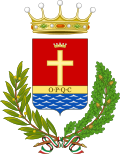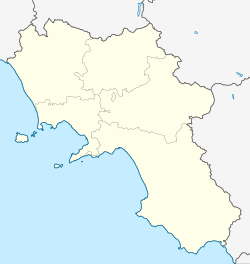Santa Maria Capua Vetere
Santa Maria Capua Vetere | |
|---|---|
| Città di Santa Maria Capua Vetere | |
 The Amphitheatre | |
| Coordinates: 41°05′N 14°15′E / 41.083°N 14.250°E | |
| Country | Italy |
| Region | Campania |
| Province | Caserta (CE) |
| Frazioni | Sant'Andrea dei Lagni |
| Government | |
| • Mayor | Antonio Mirra |
| Area | |
• Total | 36 km2 (14 sq mi) |
| Elevation | 36 m (118 ft) |
| Population (31 August 2015)[2] | |
• Total | 32,793 |
| • Density | 910/km2 (2,400/sq mi) |
| Demonym | Sammaritani or Mariani |
| Time zone | UTC+1 (CET) |
| • Summer (DST) | UTC+2 (CEST) |
| Postal code | 81055 |
| Dialing code | 0823 |
| Patron saint | St. Simmachus and Bl. Vergin Maria Assunta |
| Saint day | October 22 and August 15 |
| Website | Official website |
Santa Maria Capua Vetere is a town and comune in the province of Caserta, in the region of Campania, southern Italy.
Although not identical with the ancient Civitas Capuana, the town developed during the medieval period near the site of the Roman amphitheatre. Its name was later changed to Santa Maria Capua Vetere—with Capua Vetere meaning "Old Capua"—to reflect its historical association with the ancient city.
History
[edit]In the area several settlements of the Villanovan culture were present in pre-historical times, and these were probably enlarged by the Oscans and Etruscans. In the 4th century BCE Capuae was the largest city in Italy after Rome.
The city was damaged by Vandal ravages but later recovered and became the seat of an independent Lombard principate. However, during the struggle of the succession to the Duchy of Benevento, it was destroyed by a band of Saracens in 841 CE. The survivors mostly fled and founded the modern Capua in the site of the ancient River port of Casilinum.
What is now Santa Maria Capua Vetere started to grow slowly when several countryside residences appeared around the old Christian basilicas of Santa Maria Maggiore, San Pietro in Corpo and Sant'Erasmo in Capitolio. King Robert of Anjou made Santa Maria Maggiore one of his summer residences.
The town was known as Santa Maria Maggiore until 1861.
During World War I, Santa Maria Capua Vetere was the location of a military camp for Polish prisoners of war from the Austro-Hungarian Army, who then formed new Polish units to fight for Polish independence (see also Italy–Poland relations).[3]
Main sights
[edit]For ancient landmarks located in the territory of Santa Maria Capua Vetere, see Main sights in Capua.
The principal landmark within Santa Maria Capua Vetere itself is the basilica of Santa Maria Maggiore, which, according to tradition, was founded by Pope Symmachus in the 5th century. The original structure featured a single nave, but was expanded in 787 by the Lombard prince Arechis II of Benevento. A further renovation took place in 1666 under Cardinal Robert Bellarmine, adding two additional aisles. The church's current Late Baroque appearance results from restoration works carried out between 1742 and 1788, during which the original mosaic decoration in the apse was unfortunately destroyed.
-
Arch of Hadrian (Arco d'Adriano)
People
[edit]- Marcello Trotta, footballer, was born here.
- Pina Picierno is a member and Vice President of the European Parliament.
- Errico Malatesta was an Italian anarchist, social and political activist, writer and revolutionary.
- Frank Matano, Italian actor, presenter and voice actor.
Twin towns
[edit]See also
[edit]References
[edit]- ^ "Superficie di Comuni Province e Regioni italiane al 9 ottobre 2011". Italian National Institute of Statistics. Retrieved 16 March 2019.
- ^ "Popolazione Residente al 1° Gennaio 2018". Italian National Institute of Statistics. Retrieved 16 March 2019.
- ^ Turek, Stanisław (1928). Zarys historji wojennej 12-go Pułku Kresowego Artylerji Polowej (in Polish). Warszawa. p. 3.
{{cite book}}: CS1 maint: location missing publisher (link)
External links
[edit]- . New International Encyclopedia. 1905.





